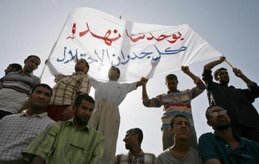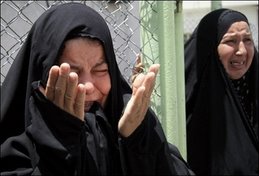Number of Iraqi displaced tops 4.2 million; shanty towns mushroom
GENEVA, June 5 (UNHCR) – The situation in Iraq continues to worsen, with more than 2 million Iraqis now believed to be displaced inside the country and another 2.2 million sheltering in neighbouring states. Calls for increased international support for governments in the region have so far brought few results, and access to social services for Iraqis remains limited. Most of the burden is being carried by Jordan and Syria.
Inside Iraq, some 85 percent of the displaced are in the central and southern regions. Most of those displaced are from Baghdad and surrounding districts. Since February last year, an estimated 820,000 people have been displaced, including 15,000 Palestinians who have nowhere to go.
"Individual governorates inside Iraq are becoming overwhelmed by the needs of the displaced. At least 10 out of the 18 governates have closed their borders or are restricting access to new arrivals," UNHCR spokesperson, Jennifer Pagonis, told reporters in Geneva on Tuesday.
"UNHCR is receiving disturbing reports of regional authorities refusing to register new arrivals, including single women, and denying access to government services. Many displaced have been evicted from public buildings," she added.
Combined with the general lack of resources, this has led to a growing number of impoverished shanty towns. The United Nations Assistance Mission in Iraq and the World Food Programme indicate that at least 47 percent of the displaced have no access to official food distribution channels.
This is a summary of what was said by UNHCR spokesperson Jennifer Pagonis – to whom quoted text may be attributed – at the press briefing, on 5 June 2007, at the Palais des Nations in Geneva.
The situation in Iraq continues to worsen, with more than 2 million Iraqis now believed to be displaced inside Iraq and another 2.2 million sheltering in neighbouring states. Calls for increased international support for governments in the region have so far brought few results, and access to social services for Iraqis remains limited. Most of the burden is being carried by Jordan and Syria.
Inside Iraq, some 85 percent of the displaced are in the central and southern regions. Most of those displaced are from Baghdad and surrounding districts. Since February last year, an estimated 820,000 people have been displaced, including 15,000 Palestinians who have nowhere to go.
Individual governorates inside Iraq are becoming overwhelmed by the needs of the displaced. At least 10 out of the 18 governorates have closed their borders or are restricting access to new arrivals. UNHCR is receiving disturbing reports of regional authorities refusing to register new arrivals, including single women, and denying access to government services. Many displaced have been evicted from public buildings. Combined with the general lack of resources, this has led to a growing number of impoverished shanty towns. The UN Assistance Mission in Iraq (UNAMI) and WFP indicate that at least 47 percent of the displaced have no access to official food distribution channels.
Read more: ►
Iraq: Situation continues to worsen, local governorates overwhelmed
This is a summary of what was said by UNHCR spokesperson Jennifer Pagonis – to whom quoted text may be attributed – at the press briefing, on 5 June 2007, at the Palais des Nations in Geneva.
The situation in Iraq continues to worsen, with more than 2 million Iraqis now believed to be displaced inside Iraq and another 2.2 million sheltering in neighbouring states. Calls for increased international support for governments in the region have so far brought few results, and access to social services for Iraqis remains limited. Most of the burden is being carried by Jordan and Syria.
Inside Iraq, some 85 percent of the displaced are in the central and southern regions. Most of those displaced are from Baghdad and surrounding districts. Since February last year, an estimated 820,000 people have been displaced, including 15,000 Palestinians who have nowhere to go.
Individual governorates inside Iraq are becoming overwhelmed by the needs of the displaced. At least 10 out of the 18 governorates have closed their borders or are restricting access to new arrivals. UNHCR is receiving disturbing reports of regional authorities refusing to register new arrivals, including single women, and denying access to government services. Many displaced have been evicted from public buildings. Combined with the general lack of resources, this has led to a growing number of impoverished shanty towns. The UN Assistance Mission in Iraq (UNAMI) and WFP indicate that at least 47 percent of the displaced have no access to official food distribution channels.
The number of Iraqis fleeing to neighbouring countries remains high. According to government figures, some 1.4 million Iraqis are now displaced in Syria, up to 750,000 in Jordan, 80,000 in Egypt and some 200,000 in the Gulf region. Syria alone receives a minimum of 30,000 Iraqis a month.
Recognition rates of Iraqis in various countries outside the region, particularly in Europe, remain low. UNHCR repeats its call for all borders to remain open to those in need of protection.
Read more:►
Iraqi Christian couple left in European limbo as they seek to join son
Source: UNHCR News StoriesPublish date: 6 Jun 2007









